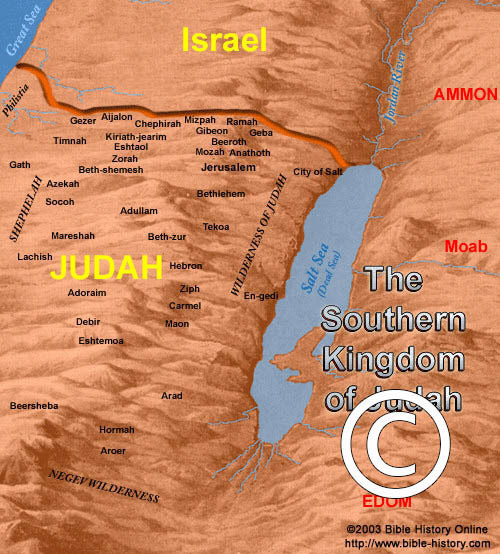
The map of the Southern Kingdom of Judah offers a captivating visual journey into the heart of one of the two biblical kingdoms that emerged after the division of Israel. Following the split of the united kingdom under Solomon, the Southern Kingdom of Judah, with its capital in Jerusalem, became a central focus of the biblical narrative.
Geographical Focus:
This map provides a detailed view of the geographical territory of the Southern Kingdom of Judah, which encompassed the southern region of ancient Israel, with Jerusalem as its political and religious center.
Jerusalem:
The map prominently features Jerusalem, the holy city, and its key landmarks, including the Temple Mount, the royal palace, and the city walls. Jerusalem served as the heart of religious worship and governance.
Tribal Territories:
It outlines the tribal territories within the Kingdom of Judah, emphasizing the inheritance of the tribe of Judah and the city's significance as the capital.
Cultural and Religious Centers:
The map marks important religious centers and sites of worship, reflecting the spiritual life and rituals of the kingdom. It highlights the role of the Temple in Jerusalem and other places of religious significance.
Prophets and Leaders:
It may indicate locations associated with the ministries of prophets, such as Isaiah, Jeremiah, and Micah, who delivered messages of faith, repentance, and warnings to the people of Judah.
Historical Context:
The map provides historical context, shedding light on the political, social, and religious environment during the time of the Southern Kingdom. It reflects the influence of foreign powers, such as Assyria and Babylon, on the region.
Conflicts and Exile:
The map may incorporate references to conflicts and the eventual Babylonian exile of the people of Judah, which had a profound impact on the history and faith of the kingdom.
Legacy and Return:
It can also include markers or references to the post-exilic period when some of the people of Judah returned to their homeland and rebuilt Jerusalem and the Temple.
The map of the Southern Kingdom of Judah allows viewers to immerse themselves in the rich history and culture of this biblical kingdom. It enables them to explore the geography, tribal divisions, historical events, and religious dynamics that shaped the destiny of the Kingdom of Judah and its enduring legacy in the biblical narrative.
Blank Topo Map of The World
Abraham’s Journey
The Captivity of Judah (586-516 B.C.)
The Fall of Judah 586 B.C.
The Northern Kingdom of Israel
The Southern Kingdom of Judah
The Divided Kingdom
The Fertile Crescent
Ur of the Chaldees
Shechem in Old Testament Times
Prophets, Kings, and Nations
Jesus Last Passover
New Testament Israel
New Testament Places
Old Testament Israel
Provinces of the Roman Empire
Israel during David’s Kingdom
David’s Kingdom
Cities of the New Testament 4
Cities of the New Testament 3
Cities of the New Testament 2
Mediterranean Sea
Cities of the New Testament
First Century Jerusalem
Empire of David and Solomon
David’s Kingdom
Israel Under Rehoboam
Ophir and Tarshish
The Period of the Kings
Ramoth Gilead
Samaria
Solomon’s Temple
Zarephath and MT Carmel
Jabesh Gilead and Tribes
Judah in the Time of David
Kingdom of Saul
Kirjath Jearim
Michmash
Mount Gilboa in the Time of David
Nob Davids Flight
Shiloh
Israel and Judah
Assyrian Empire Under Esarhaddon
Assyrian Empire Under Sennacherib
Captivity of 10 Tribes
Events in 2 Kings
The Khabur River
Israel and Syria
Captives From Judah
Kingdom of Jeroboam
Mesha’s Kingdom
Pharaoh Necho Battles King Josiah at Megiddo
Babylonian, Mede and Persian Empires
Samaria and Nearby Territories
Syria at its Height
Hebron
Mahanaim
1949 Map of Israel With Boundaries
First & Second Journeys of Paul
Journeys of the Apostles
Paul’s Third Missionary Journey
Saul’s Journey to Damascus and Arabia
Paul’s Final Visits
Paul’s 1st Missionary Journey
Paul’s 2nd Missionary Journey
Paul’s 3rd Missionary Journey
Paul’s Voyage to Rome
Phillip Journeys to Samaria and Gaza
Judah at the Time of Amos
Empire of Alexander the Great
Israel Under the Maccabees
Galilee During Maccabees
Idumea Intertestamental Period
Kingdom of the Ptolemies
Kingdom of the Seleucids
Ptolemaic Egypt Seleucid Asia
The Roman World
Kingdom of Ptolemies and Seleucids
The World During the 6TH Century BC
Mount Horeb
The Red Sea
The Exodus
Ezra’s Journey to Restore Jerusalem
Israel and Judah During Hosea’s Time
The Ancient World
Canaan During the Time of Abraham
The City of Shechem
Supposed Location of the Garden of Eden
The Land of Israel in Genesis
The Jordan River
The Kingdom of Nimrod
Mount Ararat and Mesopotamia
The Descendants
Sodom and Gomorrah
The Kingdom of Egypt
The Hamites
The Kingdom of the Hittites
Ur of the Chaldees
Judah at the Time of Haggai
Jesus Passes Through Samaria
